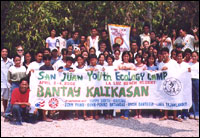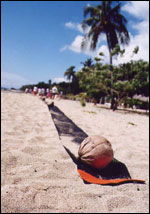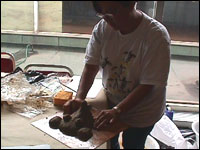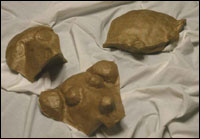Penny Reyes-Velasco is a children’s book author and collage artist, as well as executive director of Happy Earth Organization, a nonprofit that produces literature-based eco-educational materials in the Philippines.

Monday, 15 Apr 2002
QUEZON CITY, Philippines
At the end of every day, I ask myself the same questions — and for the last year, I have often been getting the same answers. The routine usually goes like this:
Q: “Ok, Penny girl, what are you doing with your life?”
A: “A balancing act, one great balancing act!
Q: “Is it hard work?”
A: “No, it’s fun play!”
Q: “Are you happy?”
A: “Yes!”
It is a challenge, you know — blending the creative and spontaneous output of pressed flower art and the organizational skills necessary to run Happy Earth — but striking the balance between the two has so far yielded a very fulfilling experience.

Group photo from the San Juan Youth Ecology Camp last week.
This week will be a particularly challenging time for me, because we at Happy Earth are in the middle of our Earth Day preparations. We will be conducting a series of eco-educational games for children on April 21 and have yet to complete the masks and props and artwork for the program.
For the last six months, Happy Earth has been conducting environmental education outreach activities in a remote fishing village in the municipality of San Juan, in Batangas province. This area is home to the endangered Philippine Teak Tree (Tectona Philippinensis) and forms part of a biodiversity corridor running from the Sierra Madre mountains of Luzon down to the provinces of Mindoro and Palawan.
I spent today working on the follow-up to a recently concluded San Juan Youth Ecology Camp, co-sponsored by the U.S. Peace Corps and the Rotaract Club of San Juan. The aim of the eco-camp, which was held earlier this month, was to mobilize youth leaders in San Juan and encourage them to come up with an Earth Day event or activity.

Timeline of the universe in a coconut-shell.
For the opening activity of the camp, we played a game called “Life on the Edge.” The game illustrated the concept of carrying capacity adaptation while energizing the participants, who were each asked to behave like a particular animal. This activity served as the springboard for sharing a creation spirituality module that we had recently developed, inspired by the works of Elisabet Sahtouris, Brian Swimm, and Thomas Berry. This module tackled evolution from the big bang up to the present — a history we helped illustrate by unfurling a timeline along the beach. At the end of the activity, we challenged the participants to find positive responses to our current ecological crises.
As part of the educational entertainment that was offered later on that day, a biodiversity theater group presented several skits about the importance of each and every plant and animal. They later helped teach the youth about interconnectedness through a game called “The Web of Life.” On the second day, the campers went on an educational hike to Naambon Falls and participated in a coastal resource orientation courtesy of the Hayuma Foundation and a waste management workshop by Happy Earth.
The final day of the camp opened with a leadership seminar conducted by a volunteer, Ishy Bantigue, who used games to bring out the natural leaders in all of our participants. The activities instilled in the youth a sense of unity and interdependence — a perfect preamble to planning the Earth Day celebration and painting a large environmental mural.
Thanks to Ishy, who braved 10 hours of travel by bus today just to meet the organizers of the San Juan Earth Day event, we now know that the participants decided to hold a “Walkathon for the Earth.” Dubbed “Alay Lakad para sa Kalikasan,” the event will feature banners and the colorful environmental mural painted during the camp, and will conclude with a river cleanup.
The sad news is that we had a very low turnout for today’s meeting. For the next four or five days, I will have to find a way to follow up with the 12 participating schools about the event, in order to secure their participation. That’s lots of work and I don’t have much time (that whole balance problem!), but its never too much work to help people realize that we all have a role to play in the protection of our home, the planet Earth.
Tuesday, 16 Apr 2002
QUEZON CITY, Philippines
All my life, I have lived in the city of Manila, the capital of the Philippines. It was only recently, when I started traveling to far-flung places as part of my nonprofit work, that I realized just how bad the pollution is in our city. Some of the places that I’ve visited are so remote and unpopulated that they seldom see out-of-towners. In these places, the air is crisp and fresh, the beaches are pristine, and the rivers are crystal-clear and sweet to the taste. Naturally, there’s no garbage problem at all.
Heading from such places back to Manila, a bustling city of 8 million people, I’m always struck by the start contrast — the strong stench of burning trash and the permanent haze of smog that envelopes the city. The root cause of the city’s garbage problem can be traced to the bad habits of its people. The Filipino “throw-away” mentality has produced an ecological and health disaster far worse than the U.S. anthrax scare. Over the years, our citizens have experienced a rapid decline in air and water quality. It is no wonder that Manila easily qualifies as one of the most polluted cities in the world.

Down in the dumps.
The town of San Juan, where we’re coordinating Earth Day events, has a burgeoning garbage problem, too. The impact is not clearly felt yet, because there are many open fields far from sight where the garbage can be dumped. To help draw attention to the problem, we have decided to design at least two Earth Day activities that will help educate people on proper solid waste disposal and management.
I spend most of today working with James, a volunteer who is helping design a series of illustrations depicting the path that a piece of plastic packaging takes from the time it is carelessly discarded till it finds its way into a dump or the open sea. Aptly titled “Plastic, Plastic, Where Do You Go?”, this activity will hopefully inspire and educate young people about the consequences of littering. We also plan to design a trash-segregation relay race for older participants.
The garbage crisis in the Philippines, as in the rest of the world, is undeniably caused by people. We at Happy Earth, being educators, believe in the potential for human beings to change for the better: There is always room for hope. It is this hope that makes us certain that just as the garbage problem was created by people, it can be solved by people.
Wednesday, 17 Apr 2002
QUEZON CITY, Philippines
On my way to work, my attention was caught by a red streamer on the side of the road, emblazoned with the words “Center for Positive Futures.” Intrigued, I decided to check the place out. I was ushered in past a school seal with “St. Joseph College” written underneath. On the opposite wall, a huge sign read, “The Alternative High School Education.”
It was then that I realized that I’d just walked into the new neighborhood school I’ve heard so much about — all good things. The school advocates integrated and thematic learning, which is refreshing compared to the all-too-rigid methodologies of many traditional schools. The school’s creativity in presenting lessons was quite impressive. Take, for instance, physics and physical education. In a traditional setting, these two subjects are normally taught separately. Here, however, they are integrated to study a specific theme, such as inertia or force.
A brochure about the school states, “The realization of our dream as Filipino parents is to provide our own children with an alternative education that would make them think critically, be socially responsible and technically adept, to prepare them to face the challenges of our increasingly complex society, but more importantly, to be peaceful and self-confident in the here and now.”
This mission statement resonated with me, because it is very similar to the values espoused by Happy Earth. Essentially, we also provide an alternative learning approach. I’m glad I dropped by, as it gives me hope for the future to know about institutions like this.
Appropriately, I spent most of my time today planning for a “positive future” for Happy Earth. Today was an extremely hectic but productive day. Joining me for a marathon strategic planning session was Karen Shih, an environmental science professor in one of our leading universities. Later in the day, another colleague stopped by to share her valuable ideas as well.
At the top of our agenda was a reassessment of the process we are going through in materials development. To understand what I mean, let me fill you in on some of the background: The Philippine government, through the Department of Education and the Environmental Management Bureau, has a prepared a 600-page Environmental Education Manual for teachers. The manual was created three years ago, but so far, it has not been successfully implemented because of a dearth of relevant indigenous educational material.
This is precisely why Happy Earth came about; to address a perceived need for such materials. First, though, we need to verify and quantify this need. One way to do so would be to conduct a nationwide study on the existing environmental materials being used in classrooms. Because this would be an expensive proposition (involving payment for transportation, food, lodging, communications, research — the list goes on and on), we next brainstormed about if and how we could actually do this. Being a small nonprofit is a disadvantage at a time like this. Like all other organizations that have noble causes but tight purses, we constantly have to pass the begging bowl and seek funding for our projects.
Eventually, we hope to assure a true “positive future” for all. Going through the arduous but reliable path of thorough information-gathering will help ensure that we meet this goal. For now, however, the thought that we are doing the most we can to achieve a sustainable planet (by educating children) is enough to give me faith in a better tomorrow.
Thursday, 18 Apr 2002
QUEZON CITY, Philippines
Early this morning, I received a telephone call from Odette Alcantara, program director of Earth Day Network Philippines. She was calling to tell me about an opportunity to talk with a reporter from a leading television network to promote events for this Sunday’s Earth Day celebration. She asked that I talk about my book, the international award it won, and the events that Happy Earth will sponsor for Earth Day.

As seen on T.V.
In addition to being an art critic, a journalist, and a champion chess player, Odette is one of the prime movers in Earth Day Network Philippines. She has been active in organizing the network’s activities and has managed to link up EDN with over 2,000 nonprofits all over the country. Although I had originally planned to work on the props for the Earth Day games during the scheduled interview with the reporter, I agreed to participate — which turned out to be a good decision on my part.
I arrived at Odette’s house at shortly past 11 in the morning. In between incoming phone calls (which never seemed to stop), she updated me on the status of the manual on solid waste management that Earth Day Network Philippines is co-sponsoring, together with Mother Earth, a nonprofit that Odette helped to found.
On Tuesday, I talked about the garbage situation in Manila. The reality in our very bureaucratic and corrupt political system is that the majority of policy makers do not understand proper solid waste management, and thus are not in a position to propose intelligent solutions to the waste problem. Instead, they came up with a 200-page guide to garbage rules and regulations, which, in Odette’s words, is more like an obstacle course than an instruction manual. Rather than answering the question, “How do I organize my waste so that it does not become garbage?, the government perennially asks the question, “Where do we dump, burn, or sink our garbage?”
The EDN Philippines/Mother Earth manual, which is simple enough for even a child to understand, emphasizes the distinction between waste and garbage, and offers examples of people and institutions who have successfully implemented a waste management system. It is essentially a course on Garbology for beginners.
The manual will be launched during the Earth Day program at Arroceros Forest Park, and the secretary of education will be present to officially endorse it. I was asked to present the secretary with a commemorative copy of my book, Are You the Forest King?, which garnered the Environmental Communications Award under “Institutions and Initiatives” of EURONATUR — the European Nature and Heritage Fund.
Another event highlight is the donation by our national sculpture artist, Napoleon Abueva, of commemorative park benches to the Forest Parks Winner Foundation. Next on the list of events is the State of the Philippine Environment Assessment, followed by the day-long free ecological waste management workshop given by Mother Earth Foundation. In the afternoon, there will be a reading of Are You the Forest King? and a series of games from Happy Earth. Other Earth Day events will be held simultaneously all over our country.
I shared these plans for Earth Day with the television reporter, Caroline Howard of ANC Channel 21. This opportunity to promote our activities was a very welcome development, and I’m glad I was given a chance to talk about our projects — not just those for Earth Day, but our environmental commitments throughout the year.
After a brief lunch with Odette and her guests, I rushed off to a mask-making workshop at the Cultural Center of the Philippines. For the Earth Day celebration, we will be playing a Turtle Race biodiversity game and we badly need masks of a crab, a rat, and an eagle — predators of newly-hatched sea turtles. Much of my afternoon was spent on making the clay molds for the masks. I’ll be back at it tomorrow, and I am looking forward to filling you in on the events of the day.
Friday, 19 Apr 2002
QUEZON CITY, Philippines
I spent all of today at the Cultural Center of the Philippines’ mask-making workshop. Unexpectedly, it was a back-breaking experience layering strips of paper with glue for my three masks — a rat, a bird, and a crab. This chance to learn mask-making came at an opportune time. These masks are direly needed as props for a biodiversity game that we at Happy Earth will be playing during the Earth Day celebration at the Arroceros Forest Park.

Mask-maker, mask-maker, make me a mask.
The Paawikan (Sea Turtle) Race is the result of our community education efforts with several coastal communities around San Juan, in the province of Batangas, which experienced sea turtle nesting last year. Through the information assistance, of Dan Torres, a representative of our governments’ Turtle Conservation Project, we were able to design a game that briefly shows the life-cycle of a sea turtle and allows the participants to experience the arduous and often dangerous life of a hatchling from the time it emerges from the nest up to the time it reaches the waterline of the beach.
The 30 players (in this case, children) will be asked to bunch up together and make their way to the finish line. Interestingly, I found out from Dan that hatchlings emerge from the nest in one burst, usually about 100 per nest, so as to assure their safety in numbers as they make their way to the sea. Because of their small size, it usually takes hours for them to traverse just a five yard stretch of beach. To emphasize this, the participants will take baby steps, one foot after another, all the way to the finish.

The masks.
The two-inch baby turtles experience a “paddling frenzy” during the first three days of their life, which gives them enough strength to reach the water and swim against the waves to the open sea. This assures their chances of survival against predators like rats, eagles, and crabs. To reenact this, the children will be asked to paddle their arms in a frenzy and at all times stay together while predators (dressed in the masks) attack from the sides and back, reducing the number of turtle participants.
In reality, only two or three of the baby turtles survive out of 100 in the wild. The poaching of eggs makes their chances of survival even worse. In our country, the eggs are considered a delicacy — and an aphrodisiac. If nests are left unchecked, poachers often raid them and whisk off the newly laid eggs to market.
Another contributing factor to low mortality is the presence of electricity and light along the beach. For a long time, I had been intrigued as to how turtles, small as they are, know exactly where to go and reach the waterline, even if their nests are far from the shore. Apparently, their reference point is the moonlight or the sunrise. This explains why turtles often hatch at night or shortly before early morning. Most residents settling along the coast now have electricity. These areas often become tourist destinations and are highly developed. When the turtles hatch in areas that are brightly lit, they get disoriented and use the strongest light source as their reference point. Thus, instead of making their way to the waterline, the turtles head for the settlements — and their deaths.
The plight of the sea turtle has been ignored in the Philippines for a long time. In the last 30 years, the number of turtles nesting on our beaches has reduced drastically. It is our hope that through novel and creative methods of education, like this game, we may be able to let the voice of the sea turtle be heard.
I have one more day to finish off the masks. All they need is a touch of paint and some varnish. As I look at the masks now, nothing about them strikes me as special. In fact, they look rather drab and unimpressive. But I suppose it is not how great they look or how laborious they were to make that matters. Rather, it is how these masks will be used to share an insight about sea turtles. By joining the fun with the learning, we can hopefully create a memorable experience for all. My fingers are crossed …


